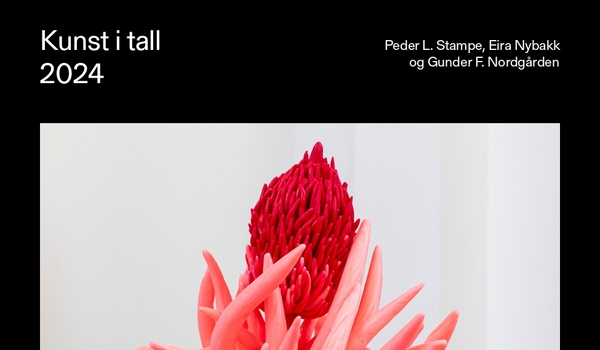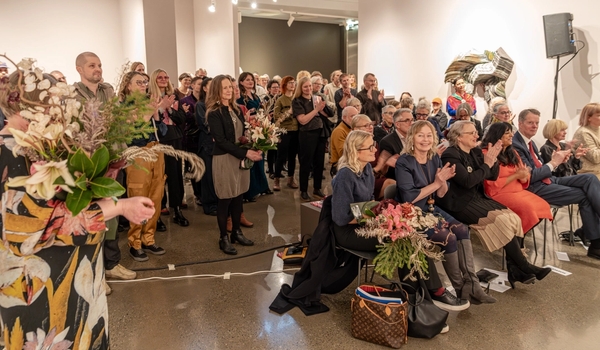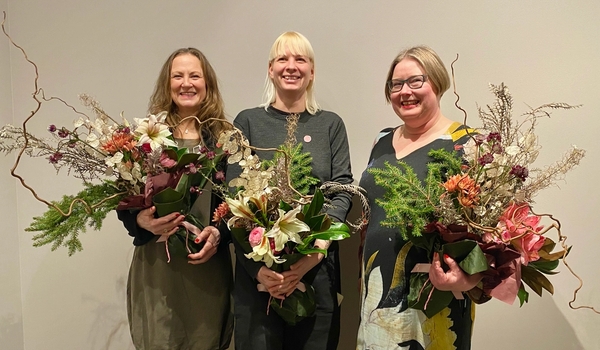Temautstillingen 2024: Ned i gruvene, opp i skyene
Norske Kunsthåndverkeres Temautstilling 2024 åpner dørene lørdag 2. mars kl. 14 i Bomuldsfabriken Kunsthall i Arendal. Gjennom verk fra 16 kunstnere og kunstnergrupper, utforsker utstillingen hvordan kunsthåndverk kan materialisere mulige virkeligheter – slipp fantasien løs!
Temautstillingen 2024 er organisert av Norske Kunsthåndverkere i samarbeid med Bomuldsfabriken Kunsthall. Temautstillingen er en årlig utstilling som søker å utfordre etablerte normer for kuratering og formidling av materialbasert kunst.
Kunstnere:
Agnieszka Knap, Audun Jansen Haga, Beatrice Alvestad Lopez, Esra Düzen, Ewelina Węgiel & Kamil Kak, Gunhild Vatn, Kalliopi Nikolou, Lin Pei-Han, Linn Halvorsrød, Masoud Alireza, Qi Tan, Rafiki i samarbeid med Patrick Bongoy, Sarah Vajira Lindström, Saskia Fischer, Siri Skjerve & Toril Redalen og Tobias Kvendseth.
Kuratorer:
Johanna Zanon, Kari Skippervold og Åse Kamilla Spjelkavik Aslaksen.
--
Scroll down for english.
I.
Kari: Hva vil du si Ned i gruvene, opp i skyene handler om?
Johanna: I korte trekk? Utstillingen utforsker fiktive landskap gjennom materialitet.
Kari: Og i litt lengre trekk?
Johanna: Utstillingen dykker dypt ned i gruvegangenes indre, hjemsøkt av underjordiske stemmer. Den lar fantasien stige mot hemmelige sky-samfunn. Ser du et fjell eller en nasjon der oppe? Den flyter gjennom en kosmisk hage, men kommer stadig tilbake til psykens innerste kroker. Si meg hva du ser i denne brosjen, og jeg vil fortelle deg hvem du er.
Kari: La oss ikke glemme at utstillingen glir gjennom dype hav, bebodd av mytiske sjøuhyrer, og vandrer gjennom posthumane sletter i en fjern fremtid…
Johanna: Man kan si at de 16 prosjektene sammen skaper et knippe fiksjonslandskap, eller det engelske fictionscapes, som forstyrrer vår virkelighet.
Kari: Som en slags sammensmeltning av fiksjon og landskap, tenker du?
Johanna: Ja, begrepet viser til fiktive scener som materialiseres gjennom kunstverk. Disse danner grunnlaget for spekulative samtider, alternative fortider og mulige fremtider.
Kari: Omfanget er jo også enormt – en idé om et bredt utkikkspunkt mot et større, fiktivt landskap.
Johanna: Nettopp! Og ordet landskap brukes opprinnelig om noe fysisk – så her sammenføyes det materielle og det immaterielle.
II.
Kari: Det var likevel ikke opplagt fra starten av den kuratoriske prosessen at vi skulle ta opp fictionscapes.
Johanna: Det er sant – før vi tok den endelige avgjørelsen med kunstnerlisten, leste jeg forfatteren Elvia Wilks essay «Death by Landscape» fra 2022. I denne teksten skriver Wilk om hvordan mennesket og landskapet flyter sammen eller bytter plass i fortellinger der kvinner forvandles til planter. Landskapet flyttes fremover i bildet som en figur i kraft av seg selv. Gjennom denne teksten fikk jeg en ny forståelse av koblinger mellom verkene, og innså hvor viktig landskap, økosystemer og spekulasjon var for den kommende utstillingen.
Kari: Den gav på et vis språk til assosiasjoner som vi intuitivt ble trukket mot tidlig i prosessen.
Johanna: Den gjorde virkelig det, og den hjalp oss med å gruppere kunstverkene – både gjennom fortellinger og i rom.
Kari: Du tenker for eksempel på de posthumane fictionscapes i verkene til Beatrice Alvestad Lopez, Esra Düzen og Qi Tan?
Johanna: Alle tre ser på mulige fremtider – fjerne eller udefinerte – og deler sine spekulative metoder. De tar opp masseutryddelse av arter, kanskje til og med mennesker, på tross av at tonen i verkene varierer vesentlig.
Kari: Et annet verk ser også dypt inn i fremtiden. Siri Skjerve og Toril Redalens bidrag spekulerer i hvordan kunsten skulle kunne se ut om 10 000 år.
Johanna: Det er i alle fall ikke posthumant! [Hun ler.] Det er derfor det gir mening å presentere verket i sammenheng med Linn Halvorsrøds lydvandring – laget til en fiktiv skulpturpark ved Bomuldsfabriken.
Kari: Det er jeg enig i, men vurderte du ikke om Halvorsrøds verk kunne høre til kategorien kritiske fictionscapes?
Johanna: Den kunne i alle fall fungere som en overgang, i og med at det er et stedsspesifikt verk plassert i en spekulativ samtid heller enn i fremtiden. Verkene knyttet til kritiske fictionscapes er godt forankret i et sted (det være seg Arendal, Norge eller Sápmi) og tid (vår samtid).
Kari: Dette gjelder verkene til Ewelina Węgiel & Kamil Kak, Kalliopi Nikolou, Saskia Fischer, Lin Pei-Han, Audun Jansen Haga og Sarah Vajira Lindström.
Johanna: Stemmer, verkenes kritiske tilnærming kobler dem sammen med komplekse strukturer, slik til og med ekstraktivisme og kolonialisme er del av større økosystemer.
Kari: Mens kunstprosjektene i seksjonen indre fictionscapes også har et kritisk blikk, er de kanskje mer forankret i det personlige.
Johanna: Jo, her vendes blikket innover med prosjekter som omhandler introspeksjon, agens og selvkritikk.
Kari: Det inkluderer verk av Rafiki, som samarbeider med Patrick Bongoy, Gunhild Vatn, Tobias Kvendseth og Agnieszka Knap.
Johanna: Det er viktig å understreke at det finnes flere koblinger enn de vi skisserer opp her. Det å se etter mønster i kunstverk kjennetegner både Agnieszka Knaps performative brosjer og Kalliopi Nikolous tegneinstallasjon. Fenomenet kalles «apofeni», altså den kognitive tendensen til å finne mening i tilfeldig stimuli.
Kari: Det leder oss videre til verket av Masoud Alireza, som forsøker å gjøre det helt motsatte! Han avviser den fiksjonelle – og narrative – kraften i tegnestreken ved å dekke arkene helt og fullt med grafitt, slik at linje blir til overflate.
Johanna: Men dette verket blir allerede kontekstualisert gjennom sin plassering i en utstilling om fiksjon. Det finnes en ambivalens mellom kunstnerens intensjon om å utslette all fiksjon og hvordan betrakteren oppfatter verket. Fantasien kan fremdeles blomstre. Og jeg ville ikke blitt overrasket om verket minner publikum om både romskip og andre elementer med opphav i science-fiction.
En fiktiv dialog mellom Johanna Zanon og Kari Skippervold*
* Åse Kamilla Spjelkavik Aslaksen var avgjørende i utviklingen av vår open call, sammen med Johanna Zanon. Utvelgelsen av de utstilte prosjektene var kuratert av Johanna Zanon og Kari Skippervold etter at Åse Kamilla Spjelkavik Aslaksen gikk ut i permisjon.
--
EN
Down in the Mines, up in the Clouds
Norske Kunsthåndverkere’s Temautstilling 2024 opens on Saturday the 2nd of March at 2 pm at Bomuldsfabriken Kunsthall. Through the works of 16 artists and collectives, the exhibition explores how craft materialises possible realities – Let your imagination run free!
Artists:
Agnieszka Knap, Audun Jansen Haga, Beatrice Alvestad Lopez, Esra Düzen, Ewelina Węgiel & Kamil Kak, Gunhild Vatn, Kalliopi Nikolou, Lin Pei-Han, Linn Halvorsrød, Masoud Alireza, Qi Tan, Rafiki in collaboration with Patrick Bongoy, Sarah Vajira Lindström, Saskia Fischer, Siri Skjerve & Toril Redalen, Tobias Kvendseth
Curators:
Johanna Zanon, Kari Skippervold, Åse Kamilla Spjelkavik Aslaksen
I.
Kari: What would you say Down in the Mines, up in the Clouds is about?
Johanna: In short? The exhibition explores fictional landscapes through materiality.
Kari: And the slightly longer version?
Johanna: The exhibition plunges down the belly of iron mines, haunted by subterranean voices, rises to the fantasy of hidden cloud societies – do you see a mountain or a nation? –, flows across a cosmic garden, only to return to the deepest corners of the psyche – tell me what you see in this brooch, and I’ll tell you who you are.
Kari: Let’s not forget the exhibition glides through the deep sea, home of the legendary kraken, and roams the posthuman plains of a distant future…
Johanna: In a sense, the 16 art projects on display bring forth a set of fictionscapes that unsettle reality.
Kari: You do like a portmanteau! What do you mean by fictionscape, a merging of fiction with landscape?
Johanna: Of sorts, yes, the concept alludes to the scenes of fiction that the artworks materialise. These fictionscapes form the basis for the speculative presents, alternative pasts and potential futures that the artworks propose.
Kari: There is also a vastness to it, an idea of taking in a sweeping view of a large fictional scenery.
Johanna: Yes, exactly! And the fact that “scape” originally refers to physical features of the terrain like land, sea, and the moon, joins together materiality and immateriality.
II.
Kari: Yet it was not obvious from the beginning of the curatorial process that we would be dealing with fictionscapes.
Johanna: True, before we made the final decisions and sealed the artists’ list, I read writer Elvia Wilk’s essay “Death by Landscape” (2022). In it, Wilk is interested in how the landscape and the human figure merge or flip in stories of women turning into plants. No longer in the background, the landscape rises to the foreground as a character in its own right. While reading the essay, I started to connect the dots between the works, and realised how important landscape, ecosystems, and speculation were for the exhibition to come.
Kari: In a way, it put words on associations we had intuitively gravitated towards earlier.
Johanna: It did, and it helped us group the artworks together – narratively and spatially.
Kari: You are thinking, for instance, of the posthuman fictionscapes, with the works by Beatrice Alvestad Lopez, Esra Düzen, and Qi Tan?
Johanna: All three of them indeed look at possible futures – distant or indefinite – and share a speculative method. They grapple with the mass extinction of species, including perhaps the human species, although the tone of their works varies considerably.
Kari: There is another artwork that looks at the distant future, by Siri Skjerve and Toril Redalen. It speculates what art may look like in 10,000 years.
Johanna: It’s definitely not posthuman! She laughs. And that’s why for me it makes sense to place it in dialogue with Linn Halvorsrød’s audio tour of a fictional sculpture park at Bomuldsfabriken.
Kari: I agree, but didn’t you imagine that Halvorsrød’s work could belong to the critical fictionscapes?
Johanna: It could, in any case, serve as a transition to this type of fictionscapes in that it is a site-specific work situated in a speculative present rather than future. The works there have a strong anchorage to place – be it Arendal, Norway or Sápmi – and time – our present.
Kari: It applies to the works of Ewelina Węgiel & Kamil Kak, Kalliopi Nikolou, Saskia Fischer, Lin Pei-Han, Sarah Vajira Lindström, and Audun Jansen Haga.
Johanna: Completely! The critical approach of these works connects them to complex structures, like extractivism and colonialism, which are themselves part of larger ecosystems.
Kari: While the art projects in the inner fictionscapes are also critical, they are more entrenched in the personal.
Johanna: True, the inner fictionscapes turn the gaze inward with projects that are concerned with introspection, agency, and self-criticality.
Kari: That includes the works of Rafiki, who collaborates with Patrick Bongoy, Gunhild Vatn, Tobias Kvendseth, and Agnieszka Knap.
Johanna: It’s important to underline that there are more connections than the ones we are outlining here. For example, the act of seeing patterns in artworks characterizes both Agnieszka Knap’s performative brooches and Kalliopi Nikolou’s drawing installation. This phenomenon is called "apophenia" – that is, the cognitive tendency to find meanings in random stimuli.
Kari: That brings us to the artwork of Masoud Alireza, who set out to do precisely the opposite! He rejects the fictional – and narrative – power of the drawing line by covering the sheet of paper entirely with graphite until the line has become the surface.
Johanna: But placing this work in an exhibition on fiction already contextualises it. There is ambivalence between the artist’s intention to erase all fiction, and the viewer’s reception of the work. Imagination may still occur. And I wouldn’t be surprised if the work reminds people of starships and other science-fiction devices.
A fictional dialogue between Johanna Zanon and Kari Skippervold*
* Åse Kamilla Spjelkavik Aslaksen was instrumental in developing the open call together with Johanna Zanon. The selection of the exhibited projects was curated by Johanna Zanon and Kari Skippervold after Åse Kamilla Spjelkavik Aslaksen went on leave.
Publisert
Sist oppdatert
Kategorier
Arrangementer


